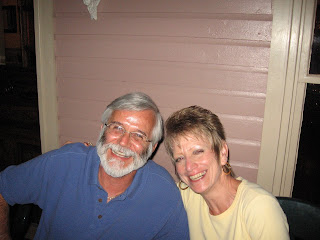 Another picture postcard fishing camp. Every town seems like it could be a postcard with so many beautiful colours and the mix of buildings, boats, sky and water.
Another picture postcard fishing camp. Every town seems like it could be a postcard with so many beautiful colours and the mix of buildings, boats, sky and water. In one stretch of about twenty miles along the gulf there were many fishing trawlers that were fishing very close to shore. In the background you can see a fog bank that is usually visible off in the distance. In another stretch of several miles the road was lined with wooden lobster pots as the season has ended. They just stack them by the highway and never worry about someone stealing them because, as we were told, that is just not the right thing to do.
In one stretch of about twenty miles along the gulf there were many fishing trawlers that were fishing very close to shore. In the background you can see a fog bank that is usually visible off in the distance. In another stretch of several miles the road was lined with wooden lobster pots as the season has ended. They just stack them by the highway and never worry about someone stealing them because, as we were told, that is just not the right thing to do. That little white speck in the water is the first iceberg we spotted. They say it is a bad year for bergs but we have seen several and most have been much, much larger than this one. You will have to take our word for it but off in the distance is the coast of Labrador where we plan to visit next week. The smudges on the windshield are bugs. We thought we may have killed them all on the drive north but this proved not to be true.
That little white speck in the water is the first iceberg we spotted. They say it is a bad year for bergs but we have seen several and most have been much, much larger than this one. You will have to take our word for it but off in the distance is the coast of Labrador where we plan to visit next week. The smudges on the windshield are bugs. We thought we may have killed them all on the drive north but this proved not to be true. This is another common sight on the Northern Peninsula. Almost every house has a clothes line and they use them every day. You can tell the women whose husbands really love them because their line is on a pulley so they never have to leave the porch.
This is another common sight on the Northern Peninsula. Almost every house has a clothes line and they use them every day. You can tell the women whose husbands really love them because their line is on a pulley so they never have to leave the porch. This is a roadside garden, another unique phenomenon here. Because most people live right on the water where the ground is very rocky, they go out along the road and plant their root vegetable gardens on land the highway department has cleared. The fences are just to keep the moose and caribou from eating the crops.
This is a roadside garden, another unique phenomenon here. Because most people live right on the water where the ground is very rocky, they go out along the road and plant their root vegetable gardens on land the highway department has cleared. The fences are just to keep the moose and caribou from eating the crops. The wood pile is another highway sight. Individuals can get a permit for eight cords of wood for personal use. It is cut in the winter and brought to the road on the sleds pulled by a snowmobile. There are thousands if not millions of cords of wood all along the road and again, no one would think of stealing it. I guess that's why in most of the small villages people don't lock their doors and most never take the keys out of the car.
The wood pile is another highway sight. Individuals can get a permit for eight cords of wood for personal use. It is cut in the winter and brought to the road on the sleds pulled by a snowmobile. There are thousands if not millions of cords of wood all along the road and again, no one would think of stealing it. I guess that's why in most of the small villages people don't lock their doors and most never take the keys out of the car.These are a few of the things you see in Newfoundland. Some things you won't see are poisonous snakes, skunks, porcupines, poison ivy and oak. It really is a friendly place.
We are as far north as we have been in the RV at over 51 degrees north latitude. This is almost 800 miles north of WashPA. We are so far north the compass does not work properly. It says we are facing west so I thought we would get the warm evening sun but instead, it is setting to our right. I learned it has something to do with the changing difference between true and magnetic north. Good thing we aren't ancient explorers. The other thing we notice is the sun rises before 5AM and does not set until 9:30 PM. We have been putting a pillow in the bedroom window so it does not awaken us to early.
















































